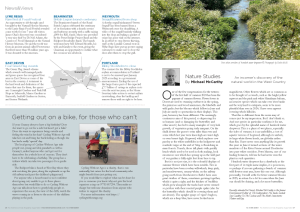By Michael McCarthy

One of the few compensations for the wetness of the first half of summer 2024 has been the pageant of summer flowers. Flower lovers in Dorset are used to stunning outbursts in the spring, the primroses and wood anemones, the bluebells and wild garlic; but the blooms which follow in June and July are rarely so spectacular in their displays. This year, however, has been different. The seemingly-continuous rain of this period, so depressing for us humans (and so damaging for butterflies and other insects) has led to many examples of very lush growth, of vegetation going truly rampant. On the chalk downs the grasses seem taller than ever and some which last year were knee-high are waist-high or even breast-high. Hogweed, which replaces cow parsley as the white umbellifer in the hedgerows and roadside verges at the end of May, is flourishing in mini-forests. Teasels, those tall plants with prickly heads which used to be used in cloth-making, look enormous: one which has sprung up in the wild part of our garden is fully eight feet from base to tip.
But it is not just size, it is the colourful displays of summer flowers which have been notable. Two in particular have been rosebay willowherb, deep pink, and meadowsweet, creamy-white; on the railway going north from Dorchester to Bath I have seen great swathes of them, sometimes growing together, which is quite a sight; and the thickets of buddleia which grow alongside the tracks have never seemed so profuse with their scented purple spikes (alas for the butterflies which should be covering them and are absent). The upright sprays of viper’s bugloss, which are a deep blue, have never looked more magnificent. Other flowers which are so common as to be thought of as weeds, such as the bright yellow ragwort and the pink-and-white Himalayan balsam, an invasive species which can take over river banks and be very hard to extirpate, seem to be more plentiful than ever in 2024; I have seen ragwort covering whole hillsides.
That this is different from the norm may of course just be my impression. But I don’t think so. And one species in particular confirms it for me, which goes by the splendid name of hemlock water dropwort. This is a plant of wet places, especially the sides of streams; it is an umbellifer, a sort of aquatic version of hogweed, although its umbels, its large white flower heads, are globular rather than flat. I have never seen anything like its growth this year: in June it turned sections of the water meadows of the River Frome around Dorchester into pure white corridors. Peter Marren, one of our leading botanists, told me he had never seen the plant in such quantities.
Hemlock water dropwort has a drawback: as the first part of its triple name implies, it is poisonous, so perhaps if you are gathering a bunch of summer wild flowers next year, leave this one out. Although personally, I would settle for fewer summer blooms in 2025, in return for a lot less rain when the June sun should be shining, and a lot more butterflies.
Recently relocated to Dorset, Michael McCarthy is the former Environment Editor of The Independent. His books include Say Goodbye To The Cuckoo and The Moth Snowstorm: Nature and Joy.




